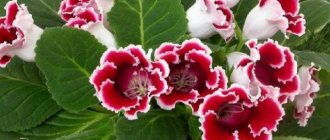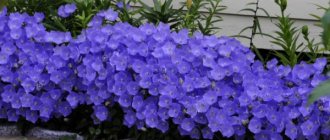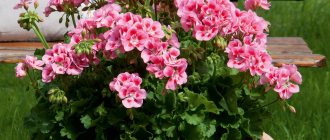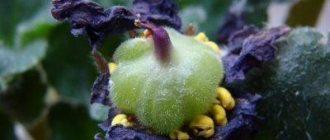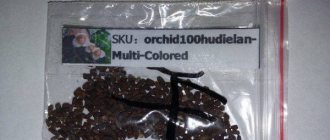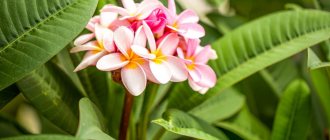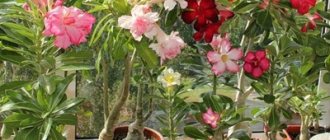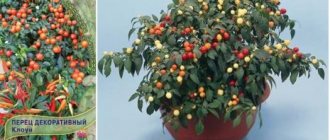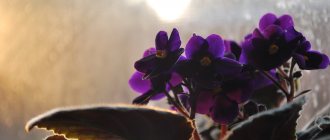HOW TO GROW SAXIFRAGY FROM SEEDS INDEPENDENTLY
You can start growing seedlings by listening to our advice. To prepare seeds for sowing in the fall:
- Wash the coarse river sand, dry it and sift it.
- Mix sand with seeds; it will prevent the seedlings from sprouting too thickly.
- Carry out stratification - cold treatment. It will speed up seed germination and allow you to get healthy and strong seedlings. The mixture of sand and seeds is placed in a shallow container, which should have a transparent lid to ensure the container is sealed. Sprinkle the seeds with a small amount of moistened sand on top and place the closed container in a cool place for approximately three weeks (at least two weeks).
Seed stratification can also be carried out by spreading them in a thin layer in containers pre-filled with soil. Then, after stratification, it is enough to place the containers in a bright place, provide an air temperature of 20 C and wait for germination. However, let's also consider a growing method in which the seeds are stratified without planting and then sown in a nutrient substrate.
Possible problems in growing
When growing a flower, many may encounter the following problems:
- the plant sheds buds and leaves. This usually occurs with a sharp change in temperature and air humidity;
- the leaves turn pale. This means that saxifrage is exposed to too bright sunlight, so it is better to shade it a little;
- The tips of the leaves dry out. The reason is too low air humidity. If you want to grow a healthy plant, you will have to spray it more often;
- The lower leaves usually fall off in older plants. This is a sign that it is time to rejuvenate them;
- pests Sometimes scale insects, spider mites or aphids can settle on saxifrage. When they appear, the plant is treated with insecticides or a soap solution;
- diseases. With excessive watering and stagnant moisture, the plant can be affected by powdery mildew, rust, and mold. Parts of the plant affected by diseases are removed, and the plant itself should be treated with copper sulfate or fungicides.
Thus, caring for Arends saxifrage is not so difficult, since it is unpretentious to growing conditions. So, by showing a minimum of care for saxifrage, you can get a flower carpet on your site that will delight you almost all summer.
Hot chocolate capsules Nescafe Dolce Gusto Chococino, 8 servings
334 ₽ More details
Nesquik Opti-Start instant cocoa drink, 250 g (package)
125 ₽ More details
Bouquets for the bride
SOIL PREPARATION
There are three ways to sow seeds:
- In purchased soil.
- In peat tablets. To plant 2-3 seeds you will need 1 piece.
- In a self-prepared mixture.
Saxifraga is a typical calciphile, that is, it needs calcium for normal growth and development. Therefore, when preparing the soil mixture, it is necessary to add chalk or limestone to it. The soil should have approximately the following composition:
- 2 parts peat soil;
- 1 tsp sand;
- 0.5 tsp vermiculite;
- 0.1 tsp chalk.
SOWING SEEDS
After stratification, the seeds are spread on the surface of the moist soil mixture. To avoid the appearance of mold on them, you should use containers with drainage holes, ventilate the containers twice a day and remove condensation from the lids. Until the seeds germinate, the crops do not need watering. The containers are covered with polyethylene or transparent lids and taken out into the light, for example, placed on a windowsill. For seedlings to germinate, it is necessary to maintain the air temperature in the room at approximately 20 C. Provided that all rules for processing and germinating seeds are followed, the first shoots can be expected in another week.
SEEDLING CARE AND TRANSPLANTING
Once the seeds have sprouted, the containers can be opened. It should be borne in mind that plants need some time to get used to fresh air after greenhouse conditions, so they need to be opened gradually. During this period, it is necessary to carefully monitor the soil; seedlings should be watered moderately with heated water. Subsequently, after the appearance of strong leaves, the seedlings are picked:
- containers are filled 2/3 with peat-sand mixture;
- make indentations in the mixture;
- Using a spoon, remove the seedlings from the container and plant each plant in a separate cup.
The first leaves of saxifrage seedlings are too weak, so experienced gardeners advise picking after the second leaf appears on the plants. Expanded clay is poured into the bottom of a low pot, soil is added (which you can buy in a store or you can prepare yourself), and then several rosettes are planted in the container.
Species recommended for gardening
There are several hundred types of saxifrage, the most popular are the following:
- Saxifraga ascending - Saxifraga adscendens;
- K. rigidifolia – Aizoides;
- K. prolomnikovaya – Androsacea;
- K. mossy - S. Bryoides;
- K. drooping – S. Cernua;
- K. soddy - S. Cespitosa;
- K. cymbal - Cymbalaria;
- K. granular - S. granulata;
- K. hawkweed - S. Hieraciifolia;
- K. swamp - S. Hirculus;
- K. hypnumovaya – Hypnoides;
- K. Korzhinsky - S. Korshinskyi;
- K. snowy - S. Nivalis;
- K. oppositeifolia - S. oppositifolia;
- K. brook – S. Rivularis;
- K. three-toed – S. Tridactylites.
When choosing a type of saxifrage for the garden, you should take into account their requirements; not every species can grow in a flower bed. To meet the expectations of plants, you need to know their natural habitat and try to reflect it in your own garden. For best results, you will need a rockery with a drainage layer. Mountain plants prefer drier conditions and will do much better on this type of rock.
The least demanding, as well as the most common species in gardens include:
- Saxifraga Arends – Saxifraga × arendsii Arends;
- K. paniculata - S. paniculata;
- K. shady or shady - S.umbrosa;
- K. rigidifolia – Aizoides;
- K. hawkweed - S. Hieraciifolia;
- K. Fortune – Saxifraga fortunei;
- K. mossy - S. Bryoides;
- K. cotyledon – S. cotyledon;
- K. rotundifolia – S. Rotundifolia;
- K. longifolia - S. Longifolia;
- K. short-pointed or lush (cushion) – Saxifraga × apiculata.
Let's take a closer look at the most common types, as well as the features of their planting and cultivation.
Arends
The most popular variety is Saxifraga Arends, which is a garden variety derived from crossing different species of the genus Saxifraga (mainly Saxifraga rosacea and Saxifraga hypnoides) growing wild in Europe and Asia.
The plant takes the form of low, cushion-shaped bushes that display decorative leaves and flowers. The leaves are wedge-shaped, deeply carved, juicy, green. Arends saxifrage flowers are variegated - white, red, pink, carmine (different shades). The plant is very low, reaching a stem height of 5 cm, not counting the peduncles, which reach 15-20 cm. Flowers appear in May.
Planting and caring for Saxifraga Arendsa does not cause any problems. Unlike its highland cousins, it is much less demanding. To grow beautifully, the plant needs to be given a slightly semi-shady position.
Preferred soil:
- humus;
- lime;
- permeable;
- quite wet.
Humidity is a very important factor in determining the beautiful appearance of a plant. During periods of prolonged drought, water shortages should be replenished. It is important to avoid open positions where Arends saxifrage may suffer in winter.
Saxifragas of this species are most easily propagated by division, although they can be propagated by seedlings in the form of unrooted rosettes. Plants are divided after flowering (from June to August), then they are easily accepted. Seeds are sown in boxes in the spring - they are not covered with soil, only slightly pressed to the ground. Seedlings need to be pricked 2-3 times.
The perennial is distinguished by its versatility of use and is used for:
- low plant - ideal for rock gardens, rockeries;
- planting along the walls;
- flower beds;
- outline of tracks;
- grows well on the edges of water bodies;
- flowers can be cut into bouquets.
| Variety | Photo |
| “Feuerwerk” – a saxifrage variety characterized by carmine flowers | |
| "Highlander Red" - with red flowers. | |
| "Ingeborg" - dark red variety | |
| "Rosenzwerg" - low variety with carmine-colored flowers | |
| “Butter Creme” – with cream flowers | |
| "Schneezwerg" - low variety with white flowers | |
| "Peter Pan" - with carmine-colored flowers, stem height 10-15 cm | |
| "Weisser Zwerg" - white flowers, 5 cm high | |
| "Purpurteppich" - dark red flowers | |
| "Triumph" - with dark red flowers. | |
| "Schneeteppich" - white delicate flowers |
Shadow
The hybrid originated from two species Saxifraga x spathularis and Saxifraga umbrosa. One of the most beautiful saxifrages, preferring semi-shaded and shady positions, humus and fairly moist soil. The decorative appearance of saxifrage is given by leathery leaves collected in rosettes, which in the “Aureopunctata” variety are also variegated (yellow).
The leaves have a grooved edge, the flowers are collected in loose panicles, star-shaped, white with a red center. The height of the flowering bush can reach 30 cm. Flowering occurs in May. It reproduces best by division. Ideal for shady rockeries as a ground cover.
| Variety | Photo |
| "Aureopunctata" - an original variety with very decorative yellow variegated leaves | |
| "Elliott" - the variety is characterized by smaller size, pink flowers | |
| "Variegata" - with yellow spotted leaves |
Paniculata
A type of saxifrage that deserves attention is paniculata (Saxifraga paniculata), decorative due to leaves collected in rosettes and inflorescences collected in loose umbrellas. Blooms in May – June. The rosette that creates the flower shoot dies after flowering. Before flowering, the height of the plant usually does not exceed 10 cm. The height of flowering saxifrage reaches 20-25 cm. It is found naturally in Europe and Asia. It has a compact pillow-shaped shape.
Paniculate saxifrages are grown in sunny rockeries, protected from the wind, in well-lit, warm, dry places.
The soil should be:
- permeable, well drained;
- moderately fertile;
- limestone;
- The species can grow in rocky soil poor in nutrients.
Paniculate saxifrage is frost-resistant. The species reproduces by division. It can be planted in autumn or spring. Seeds are sown in summer. Young seedlings should be watered on hot days; older ones tolerate drought well. Regular weeding is important for maintenance. The plant does not require fertilizer.
Usage options:
- decoration of rock gardens;
- creating flowerbed edges;
- looks good planted among stones, in the crevices of walls;
- creates interesting compositions with young plants and sedum.
It is better not to plant paniculate saxifrage with expansive plants; they will quickly choke it.
| Variety | Photo |
| "Atropurpurea" - dark red flowers | |
| "Rosea" - pink flowers |
Fortune
An Asian beauty that blooms only in autumn, Saxifraga Fortune delights with leaves that form beautiful rosettes. The wavy edges of the leaves and the red color of the underside give the plant a decorative touch. Against the background of the leaves, cream or pink flowers collected in loose inflorescences look beautiful.
For the cultivation of Saxifraga Fortune to be successful, it must be provided with a shady position, humus, fertile, permeable and moist soil. The plant prefers an acidic environment.
| Variety | Photo |
| "Snow Conwy" - with beautiful brownish leaves on which delicate, white flowers look great |
Cotyledon
Saxifraga cotyledon is a less demanding species, found in its natural habitat in the Alps. The height without flowering shoots is 10-15 cm, during flowering the height reaches 50 cm. Fleshy and serrated leaves form large rosettes from which the peduncle grows. After flowering the rosette dies, but before this happens it will create many new rosettes. White flowers appear in June, forming paniculate inflorescences.
For successful cultivation, it is important to take care of a permeable substrate. In terms of planting location, the plant is very tolerant and grows well in sunny and semi-shaded positions. Cotyledon should not be grown in an overly alkaline environment; slightly acidic or neutral soil is ideal.
A hardy species, it is most easily propagated by division.
Opposite foliage
The perennial saxifrage oppositeifolia in its natural environment (Alps) creates low carpets. The height of the plant can reach 5 cm, during flowering it is much higher. Thanks to its numerous flowers, the plant is very decorative during flowering (spring).
The plant should be provided with permeable soil and a quiet place, preferably in light partial shade.
Cortusifolia
In spring and summer, small bunches of beautiful carved leaves 5-8 cm wide with long petioles can be mistaken for a variety of heuchera. However, this is a completely different plant - Saxifraga cortusifolia, native to China, Japan or Korea.
This species owes its name to leaves similar to those of the mountain currant (Cortusa matthioli). In autumn, this unusual species gives a pleasant surprise - it creates inflorescences 40 cm high, consisting of several dozen small, usually white flowers 1.5 cm in size. Breeders have also obtained pink varieties. In the autumn garden they all delight.
Khosta
An interesting species is the Hosta saxifrage (Saxifraga hostii) - an evergreen perennial. The name saxifrage is associated with hosta. Both of these plants were discovered and described by Nikolai Thomas Host, an Austrian botanist.
Hosta saxifrage produces low rosettes of leaves up to 15 cm in diameter. The leaves are dark green, narrow (1 cm wide), long (up to 10 cm). Rosettes of leaves turn red in autumn. From the middle of the rosette in June - July, tall (up to 60 cm) inflorescences develop, on a thin, unbranched stem - “leg”. The flowers are white, sometimes purple spotted. Individual flowers are collected in panicles (5-20 flowers per inflorescence).
Saxifraga Hosta grows best in well-drained, calcareous soil in a sunny, dry location. This is a plant with high frost resistance. Does not require winter protection.
The plant is often used for:
- rock gardens;
- planting on slopes;
- along the walls;
- can be planted in wide and flat pots on the terrace.
Plants should be planted in small groups of several to create evergreen cushions.
Soddy
The perennial saxifrage soddy is ideal for rockeries. The plants create low, flat rosettes that look like soft green cushions. The leaves are small, evergreen, pinnate. Small, white, five-petaled flowers grow on thin, reddish peduncles, growing up to 10-15 cm in height. It blooms at the turn of April - May. Often the rosette that created the flower dies after the plant has flowered.
The species grows best in semi-shaded or sunny positions. If in full sun, it requires frequent watering. The soil should be well-drained, slightly moist, humus, and calcareous.
Soddy saxifrage looks better in the company of stones. It can also grow in low beds, walls, between paving slabs or in pots. Plants are planted in small groups in close proximity to other perennials with similar requirements. After flowering, flower stalks should be trimmed.
The species is propagated by division in the spring. Plants (especially young ones) can freeze in cold and snowless winters, so you need to cover them with spruce branches.
Mossy
Saxifraga bryoides L. – the mossy saxifrage is found in the mountains of Central Europe. The small perennial forms dense turf. The entire plant is pale or yellow-green, with older leaves silvery-gray. The plant produces numerous inflorescences and several flower stalks. This is a high-mountain species (rudophyte).
In the axils of the leaves there are large inflorescences with rose-shaped petals. Thick, fleshy leaves 3-7 mm long, lanceolate with sharp edges and sharp bristles, characteristically curved upward. Single flowers on unbranched, low (1.5-5 cm) peduncles. The flowers are light yellow and orange spotted.
musky
Found in the mountains of Southern and Central Europe. In the east, the range extends through the northern Balkans, the Caucasus and Altai to the Sayan Mountains.
This is a sod-bearing species with a height of 2-12 cm. The entire plant is pubescent with soft hairs. The stem is straight, light green. The leaves are light green, with a gradually tapering base. Flowers grow at the tops of peduncles, forming a tuft or panicle, yellow-green in color.
| Variety | photo |
| "Cloth og Gold" |
LIGHTING
Saxifraga will feel great on a windowsill located in the western or eastern part of the house. You can also place a container with saxifrage on a windowsill that faces north. However, if you decide to leave the flower on the south side, you will have to make sure that the plant does not receive direct sunlight. In winter, saxifrage, like many other plants, needs additional lighting. As for the warm period, saxifrage can be taken out to the balcony. The main thing is to choose a place where neither bright sun nor rain will disturb the delicate saxifrage.
When to sow saxifrage seeds for seedlings and in open ground
To properly sow saxifrage for seedlings, you need to choose the appropriate timing. Usually the crop is planted in mid- or late March at home. First, the perennial seeds are stratified in the cold - the process should take at least a month.
Planting in open ground is carried out in late autumn just before the onset of cold weather. In this case, the seeds undergo natural stratification during the winter, and in the spring they sprout vigorously immediately after warm weather sets in.

